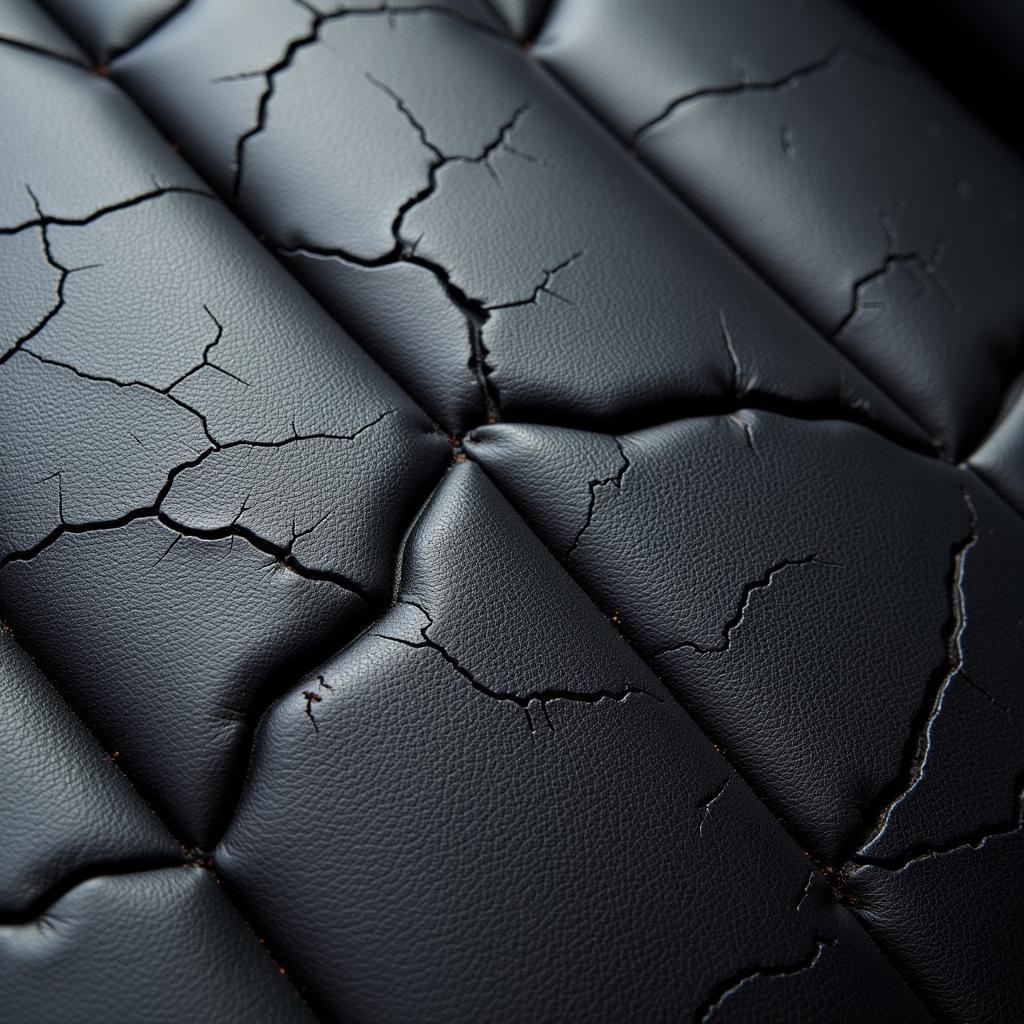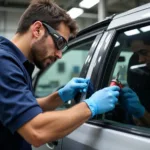Leather car seats add a touch of luxury and comfort to any vehicle. However, over time, they can develop cracks due to wear and tear, sun damage, and lack of maintenance. While a professional repair is ideal, you can often fix minor to moderate cracks yourself. This guide will provide a step-by-step approach on how to repair leather car seat cracks, saving you money and restoring your car’s interior to its former glory.
Understanding Leather Car Seat Cracks
Before diving into the repair process, it’s important to understand why leather car seats crack. The main culprits are:
- Sun Exposure: UV rays dry out the leather, making it brittle and prone to cracking.
- Heat: Excessive heat, like that from a hot car interior, can accelerate the drying process.
- Wear and Tear: Regular use, friction from clothes, and sharp objects can cause abrasions that develop into cracks.
- Lack of Maintenance: Leather needs regular cleaning and conditioning to stay supple and prevent drying.
 Leather Car Seat Cracks
Leather Car Seat Cracks
Assessing the Damage: Can You DIY?
Not all leather car seat cracks are created equal. While DIY repairs can address minor to moderate damage, severe cracks might require professional intervention. Here’s a quick assessment:
- Minor Cracks: Hairline cracks or superficial scratches can be easily repaired with a leather filler and dye.
- Moderate Cracks: Cracks that expose the padding beneath require a more involved repair using leather patches or liquid leather filler.
- Severe Cracks: Deep, widespread cracks affecting the seat’s structural integrity are best left to professionals.
Gathering Your Leather Car Seat Repair Kit
For DIY leather car seat crack repair, you’ll need a few essential supplies:
- Leather Cleaner: Removes dirt, grime, and oils that can hinder the repair process.
- Leather Prep Solution: Cleans the leather’s pores and creates a better surface for the filler to adhere to.
- Leather Filler: Fills in cracks and creates a smooth surface for dyeing. Choose a filler specifically designed for leather.
- Leather Dye: Matches the color of your car’s leather to create a seamless repair.
- Applicator Tools: Sponges, brushes, cotton swabs, and a palette knife are useful for applying the various products.
- Masking Tape and Plastic Sheeting: Protect surrounding areas from accidental spills and overspray.
- Gloves and Eye Protection: Ensure safety while working with chemicals.
How to Repair Leather Car Seat Cracks: A Step-by-Step Guide
Follow these steps for a successful DIY leather car seat crack repair:
-
Clean the Area: Thoroughly clean the cracked area with a leather cleaner and a soft cloth. Remove any dirt, dust, or debris lodged in the cracks.
-
Prepare the Surface: Use a leather prep solution to remove any remaining residue and ensure proper adhesion of the leather filler.
-
Apply Leather Filler: If the crack is deep, use a leather patch underneath to provide support. Then, apply the leather filler with a palette knife, pressing it into the crack and smoothing the surface. Allow it to dry completely according to the manufacturer’s instructions.
-
Sand and Smooth: Once dry, gently sand the filled area with fine-grit sandpaper to create a seamless transition. Wipe away any dust.
-
Apply Leather Dye: Choose a leather dye that closely matches your car’s interior color. Using a sponge or brush, apply thin, even coats of dye to the repaired area, blending it into the surrounding leather. Allow each coat to dry completely before applying the next.
-
Apply Leather Conditioner: After the dye dries, apply a high-quality leather conditioner to the entire seat to moisturize the leather and protect it from future damage.
Prolonging Your Leather Car Seat’s Lifespan
To prevent future cracks and keep your leather car seats looking their best, follow these maintenance tips:
- Regular Cleaning: Clean your seats regularly with a leather cleaner to remove dirt and grime that can damage the leather over time.
- Conditioning is Key: Apply a leather conditioner every few months to keep the leather supple and prevent drying and cracking.
- Avoid Sun Exposure: Park your car in the shade or use a sunshade to protect your leather seats from harmful UV rays.
- Address Spills Immediately: Quickly clean up any spills on your seats to prevent liquids from staining or damaging the leather.
Seeking Professional Help: When to Call the Experts
While DIY repairs can be effective for minor to moderate cracks, certain situations call for professional expertise:
- Extensive Damage: If the cracks are widespread, deep, or affect the seat’s structural integrity, a professional can assess and provide the best course of action. You can find a reputable car upholstery shop or leather repair specialist in your area.
- Airbag Deployment: Never attempt to repair leather seats that have been involved in an accident where airbags have deployed. The seat’s structure might be compromised, and professional attention is crucial for safety.
Conclusion
Repairing leather car seat cracks is an achievable DIY project that can save you money and restore your car’s interior. By following the steps outlined in this guide and investing in the right products, you can address minor to moderate damage effectively. Remember to assess the severity of the cracks before starting and don’t hesitate to seek professional help when needed. With proper care and maintenance, you can keep your leather car seats looking their best for years to come.
FAQs About Repairing Leather Car Seat Cracks
Can I use super glue to fix a leather car seat crack?
We strongly advise against using super glue on leather car seats. It can create a rigid bond that can crack further with use and make professional repair more difficult.
What is the best leather filler for car seats?
Several reputable brands offer leather fillers specifically designed for car seats. Look for fillers that are flexible, durable, and match your leather’s texture.
How long does it take for leather dye to dry?
Drying time varies depending on the type of dye and environmental conditions, but most leather dyes require at least 24 hours to dry completely.
Can I prevent leather car seats from cracking in the first place?
Yes, regular cleaning, conditioning, and protecting your seats from sun exposure are crucial for preventing cracks.
How much does it cost to have a leather car seat professionally repaired?
Professional repair costs vary depending on the extent of the damage, the type of leather, and the location. It’s best to get a quote from a reputable shop for an accurate estimate.
For more information on car seat repair, you can visit our other helpful resources:
- Can a VW Golf Leather Car Seat Be Repaired?
- Audi Volkswagen Seat Skoda Car Servicing & Repairs Warwickshire
- Car Driver Seat Repair
If you have any further questions or need assistance, our team of car care experts is always ready to help. Contact us via WhatsApp: +1(641)206-8880, or Email: [email protected]. We offer 24/7 customer support to address all your car repair and maintenance needs.


